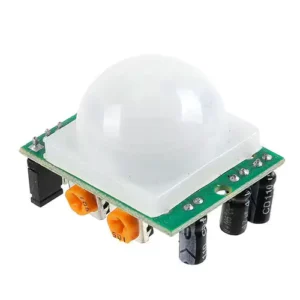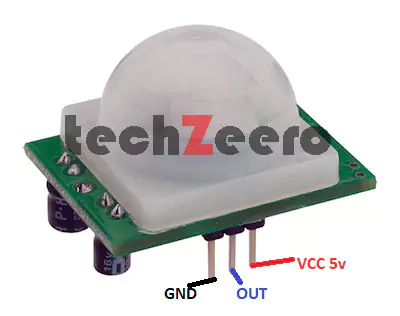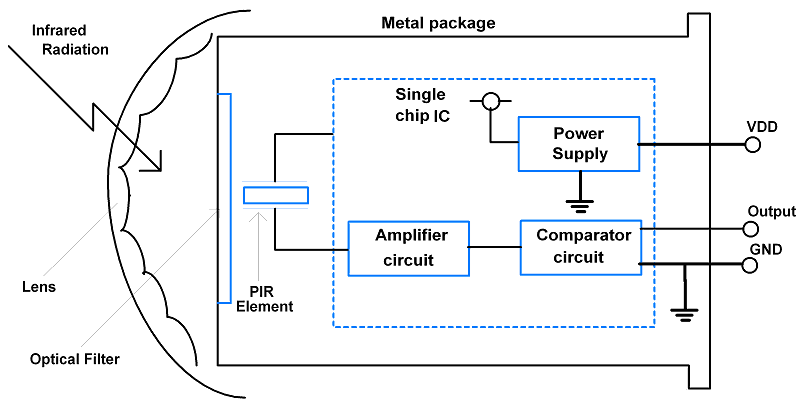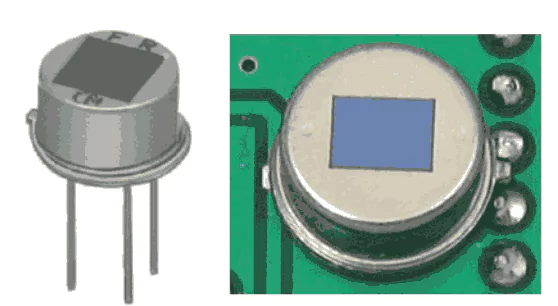What is a PIR (Passive Infrared) Sensor?
A passive infrared sensor (PIR) is an electronic sensor which is used to detect motion. The sensor measures infrared (IR) light radiating from objects in its field of view. Mainly they have used in PIR based motion detectors.
When a person in the field of the sensor moves, it detects a sudden change in infrared energy and the sensor is triggered (activated). It acts as a switch.
They don’t detect or measure Heat, but they detect infrared radiation emitted from objects.
These sensors commonly used in security, lighting, and alarm systems.
The range of PIR sensors is approximately 6 meters, depending on conditions.
Related Article: Learn How to use PIR Sensor with Arduino

PIR Sensor Pinout
The pinout of a PIR sensor typically consists of three pins: VCC, OUT, and GND. These pins are essential for connecting the sensor to a power source and microcontroller.
The VCC pin is where you connect the positive terminal of your power supply, usually ranging from 3V to 5V. The GND pin is connected to the ground or negative terminal of the power supply.
The OUT pin is crucial as it sends a digital signal to your microcontroller when motion is detected. This signal can trigger various actions, such as turning on lights or sounding an alarm.

Hardware Connections
- Vcc to 5V of Arduino.
- GND to GND of Arduino.
- OUT to Digital pin 8(D8) of Arduino.
Specifications of PIR Sensor
These sensors typically operate at 3.3V or 5V and have a detection range of around 20 feet with a 110-degree field of view.
| Operating voltage | 5V to 20V |
| Power Consumption | 65 mA |
| TTL output | 3.3V, 0V |
| Delay time | Adjustable (.3 to 5min) |
| Sensing range | about 120° and 7 meters |
How PIR Sensor Works
Imagine having a sensor that can detect movement based on heat signatures – that’s what a PIR sensor does! When an object moves in front of the sensor, the sensor detects the emitted infrared radiation. This change in infrared radiation triggers the sensor to send a signal, indicating motion.
When PIR detects a motion of any object the output voltage is high because of its sense infrared radiation whereas it is low when there is no motion.
The magic behind this lies in the pyroelectric sensors within the PIR device. These sensors can detect changes in temperature and convert them into electrical signals. As warm objects move across its field of view, they cause these temperature fluctuations that set off the alarm or activate lights.
This unique technology enables PIR sensors to detect human presence effectively without being triggered by other environmental factors such as light changes or sound.

PIR Element

- PIRs consist of pyroelectric sensors, which can be use to detect levels of infrared radiation.
- In the above image, PIR has a round metal can in which there is a rectangular crystal in the center.
Uses / Applications
- Automatic Doors which open and close on Motion Detection.
- All Outdoor Lights.
- Lift Lobby.
- Motion Cameras.
- Lights on/off by Motion Detection.
- Basement Parking Areas.
- Escalator Lights(Staircase).